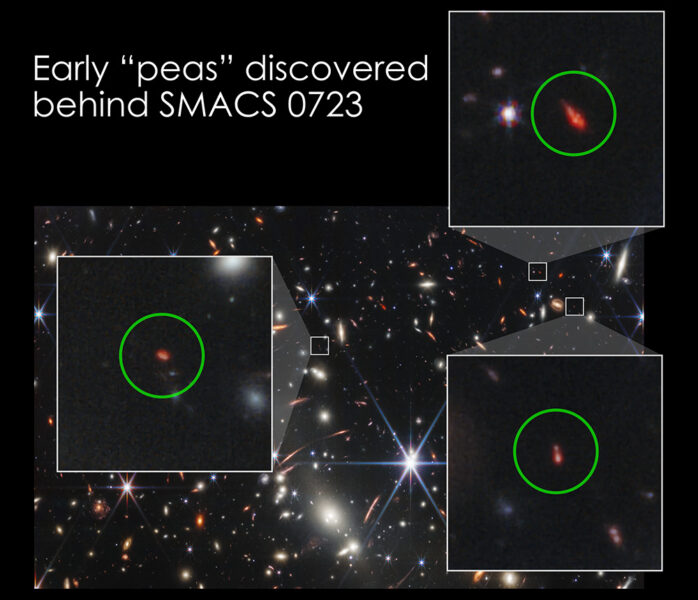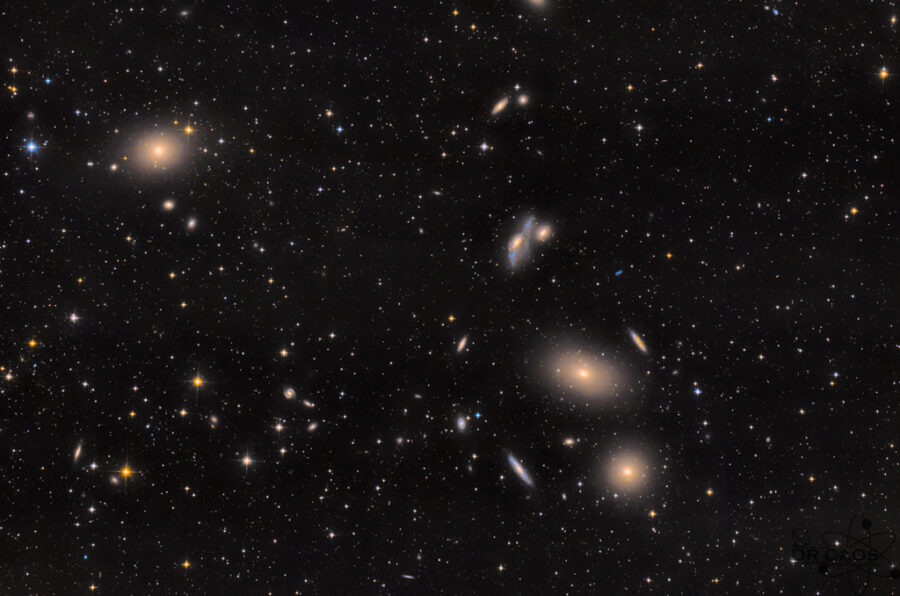Astronomers presented results on galaxies near and far at the recent meeting of the American Astronomical Society.
JWST Images Galactic Building Blocks

NASA / ESA / CSA / STScI
Behind a massive galaxy cluster imaged by the James Webb Space Telescope (JWST), astronomers have discovered three tiny but mighty balls of stars that are key to understanding how galaxies grow.
These distant galaxies are remarkably similar to “green peas,” an exceedingly rare type of compact galaxy that citizen scientists discovered in 2007 in the million-plus galaxy catalog of the Sloan Digital Sky Survey. Green peas are less than 5,000 light-years wide (compared to the Milky Way’s 100,000 light-year span), and they shine a distinctive green due to the light of doubly ionized oxygen, a signature of furious star formation.
The JWST galaxies aren’t green at all; they appear red even in infrared images because their light, coming from the cosmic dawn, has stretched as it passed through the expanding universe. Nevertheless, their spectra show that they’re similar to the nearby green peas, with the distinctive signatures of pristine gas set alight by newborn stars.

NASA’s Goddard Space Flight Center / Rhoads et al. 2023
“The early ‘green pea’ galaxies are likely building blocks of more massive, mature galaxies that they may grow into later,” explains James Rhoads (NASA Goddard Space Flight Center), who led the study published in the Astrophysical Journal Letters and presented results at the 241st meeting of the American Astronomical Society.
Interestingly, these building blocks coexist with more mature galaxies even at early times. But this isn’t a surprise, Rhoads says, because different parts of the universe will evolve at different rates. “Indeed,” he adds, “the fact that we see green peas nearby already tells us that young galaxies can cohabit the same universe with much larger and more ‘mature’ galaxies.”
— Monica Young
Survivor Galaxy Has an Invisible Shield
The galaxy VCC 615 is weird: It’s a faint, fragile-looking galaxy in the Virgo Cluster, a bustling metropolis of galaxies roughly 50 million light-years away. Objects like VCC 615, called ultra-diffuse galaxies, have a range of characteristics and possible origins, some stripped down by interactions and others born the way they are.
VCC 615 in particular presented a puzzle, because it appears to lie in the cluster’s dense core. How could such a diffuse galaxy survive that pell-mell environment?

Kees Scherer / Flickr
To find out, Chris Mihos (Case Western Reserve University) and his colleagues used ground- and space-based observations to pinpoint the galaxy’s distance and motion. They found that VCC 615 actually isn’t in the Virgo Cluster’s center but rather near its outer edge — specifically, the back side, from our perspective — and that it’s on an outbound orbit that likely took it through the cluster’s core in the past billion years.
Yet it’s not torn up: There are no clear contortions from interactions with other galaxies.
The team wondered if VCC 615 might be protecting itself with a vast cocoon of dark matter. Not all ultra-diffuse galaxies have dark matter cocoons; some appear to have lost most of their invisible halos. The team counted up VCC 615’s globular clusters, which indicates how massive the galaxy really is. Sure enough, VCC 615 has far more heft than appears to the eye, enough to shield the galaxy from the dangerous cluster environment, Mihos reported January 10th at the winter AAS meeting.
Or, at least for now. VCC 615’s nucleus is big, bright, and off-center, and it looks a lot like stripped-down galaxies called ultracompact dwarfs. There are also tantalizing hints that its collection of globulars is being pulled out and away. Perhaps, Mihos suggested, we’re seeing a galaxy in the midst of a slow transformation, changing from one kind of galaxy to another.
— Camille M. Carlisle
 0
0









Comments
You must be logged in to post a comment.